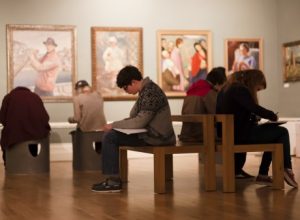Our KS3 Curiculum in Art and Design
( Why We Study It:
Why We Study It:
As a department, we see ourselves as a safe space in which students are encouraged to take risks, free their imagination and explore their creativity as individuals. We deliver high quality, inclusive teaching and learning that allows students to learn from experience when exploring and experimenting with ideas, processes, media, materials and techniques that they may not have access to elsewhere.
We want our students to actively engage in the creative process of art, craft and design in order to develop as effective and independent learners, and as critical and reflective thinkers with enquiring minds. Cooperation and collaboration is valued and fostered through a variety of group activities at all stages of the curriculum.
We value and recognise the impact of allowing our students to celebrate their personal responses and visual outcomes both in school and the wider community.
We strive to develop our student’s knowledge, appreciation and understanding of art, craft and design in a variety of historical and contemporary contexts, and we draw our influences from an exciting range of geographical and cultural contexts.
In summary it is our intention to nurture our students’ Imagination and creativity, allowing all our learners to realise their creative thoughts and ideas with the aim of enriching their lives both in school and beyond.
What We Study:
|
YEAR 7 |
Rotation A: Colour Theory We study colour theory and use this knowledge to create a colour wheel. The key skills of colour mixing and paint application are developed and contextualised through looking at a range of inspirational artists. Students create imaginative personal responses using a variety of different media and techniques, such as tempera watercolour techniques, how to evenly apply and blend coloured pencils and accurately mixing colours to camouflage a section of a painting. Here we focus primarily on the development of students’ imagination as this builds confidence which is built upon in year 8.
Rotation B: Landscapes We study the local Landscape and the artists associated with it. Students learn how depth is created using Tone, Colour, Perspective and Scale. We then compare the local landscape to that of the Aboriginal culture introducing students to examples of non-European art. Students create their own aerial image of their local environment in this style, using symbols and abstraction to represent their world creatively. |
|
YEAR 8 |
Rotation A: Elements We study the Elements of art and how to identify and apply line, shape, form, colour, texture and tone. We explore the application of the formal elements through a variety of media and techniques including drawing, painting and relief printmaking. Students are introduced to the work of a range of artists to contextualise their knowledge and deepen their understanding of how these formal elements are used in different cultures and art movements .
Rotation B: Mythology We study Mythology and folklore around the world and the intrinsic links between authors and illustrators in the creative sectors. We use this knowledge to contextualise Myths that we know in our own Culture. Ideas are developed through the creation of visual responses which are taken from second hand observation drawing. As a department we have our own kiln which provides students with the opportunity to practise and develop a variety of ceramic based skills and techniques before designing a ceramic mug that is based on a mythological creature. They use slab and slip techniques to create their own ceramic mug, painting it with coloured slips before taking home the finished glazed mug. |
|
YEAR 9 |
Rotation A: Mix Media & Modernism We study Pop Art and start by creating a painting in the style of Roy Lichtenstein. We then create a cardboard food sculpture inspired by Claes Oldenburg, printmaking inspired by Andy Warhol and a mixed media number painting inspired by Jasper Johns.
Rotation B: Portraiture and Natural forms Students’ contextual understanding is further developed as they are introduced to the Artwork and architecture of Friedensreich Hundertwasser. Building on the foundations learnt in year 7 and 8 students are introduced to portraiture and natural forms whilst acquiring the technical skills such of composition, form and proportion from first hand observation drawing. They draw natural forms from observation which they then morph into a ‘landscape’ into which they apply their portrait. This project increases pupils’ skill levels, confidence and creativity. |
| Year 10 | Students will follow this broad, unendorsed syllabus as set by the AQA Exam board: Coursework often begins with work on a theme developed from a broad starting point, stimulated by a visit to a local gallery or other place of interest.
This is explored and expanded through work in a wide range of media (including various kinds of painting and drawing, photography, printmaking, mixed media, sculpture and ceramics) and through critical studies of relevant artists. |
| Year 11 | In year 11 students complete a last module of Coursework in the Autumn term, where we encourage an independent approach to the direction of work.
In the Spring term the externally set assignment begins. The exam board gives students a list of 6 starting points to choose from. As an ‘independent study’, students can work in a way that suits their aspirations and ideas. Throughout the course we holistically foster and develop core skills allowing students to develop, refine, create and present their own individual visual responses via self selected media and techniques. |
SCHEME OF ASSESSMENT – 7 week rotation
Week 1 |
Week 2-7 |
End of rotation |
|
| Students prior learning is measured via a Baseline activity or via the summative comments from the last rotation. | Practical work is assessed holistically throughout the rotation using a mixture of peer feedback, self assessment and verbal feedback. During each rotation two pieces of work will be formatively assessed against shared success criteria. EBI/WWW feedback comments are used to inform students of the next steps. | A summative holistic grade will be awarded at the end of the rotation which reflects their ability and responses to the main assessment aims of each project. | |
| 7 A
Colour Theory |
Students prior learning is measured via a Baseline activity that assess their
Observational drawing skills, Imagination and their ability to generate creative responses. |
A ‘camouflage’ project is assessed for creativity, accuracy of line drawing, colour mixing and matching and the precise application of paint.
A drawing project based on the work of Jon Burgerman is assessed for presentation, design ideas, application of colour and coloured pencil techniques. |
A summative holistic grade will be awarded at the end of the rotation which reflects their ability and responses to the main assessment aims of each project. |
| 7 B
Landscapes |
Draw a landscape from your imagination. Shows prior knowledge of depth, tone, scale and perspective. | A single point perspective drawing. Assessment Criteria: Are all the vertical lines actually upright? Do the edges of the buildings converge to a single point?
Pastiche painting of a local landscape. Assessment Criteria: Accuracy of drawing, accuracy of colour matching and technique. |
A summative holistic grade will be awarded at the end of the rotation which reflects their ability and responses to the main assessment aims of each project. |
| 8 A
Elements |
A small quiz is taken at the start of the rotation to assess prior understanding of the Elements of Art. This is self assessed. | Van der Steen inspired paintings are assessed for the understanding and application of the formal elements as well as composition, presentation and use of painting techniques.
A pattern project is assessed for developing and designing original pattern motifs and applying them to create a repeat pattern using relief printing methods. |
A summative holistic grade will be awarded at the end of the rotation which reflects their ability and responses to the main assessment aims of each project. |
| 8 B
Mythology |
Q&A session about mythical creatures, what they are and where we have seen them. Links to writers and illustrator combinations (Tolkien and Lee – | A rendering exercise using a circle. Peer Assessment Criteria: Is the blending of tones smooth? Does the circle appear to be a sphere?
Mythical creature mug designs. Peer Assessment Criteria: Quality of drawing, including rendering. Use of Creativity and imagination in the design. Peer assessed. |
A summative holistic grade will be awarded at the end of the rotation which reflects their ability and responses to the main assessment aims of each project. |
| 9 A
Mix Media & Modernism |
A small quiz is taken at the start of the rotation to assess prior understanding of Pop Art. This is self assessed. | Observational drawing techniques are assessed for accuracy of line, proportion and application of tone to create form.
A printmaking project is assessed for technique, application of colour and composition. |
A summative holistic grade will be awarded at the end of the rotation which reflects their ability and responses to the main assessment aims of each project. |
| 9 B
Portraiture and Natural forms |
Students draw a portrait with no teacher guidance. Use of portrait proportion guide and then redraw portrait to measure improvement and areas of strength and weakness. | Shaded tonal self portrait. Peer assessment criteria: Is the proportion accurate? Is the shading describing the form of the face?
Composition for final painting. Self Assessment Criteria: Does my eye stay within the page? Is my design dynamic? |
A summative holistic grade will be awarded at the end of the rotation which reflects their ability and responses to the main assessment aims of each project. |
KS4 – SCHEME OF ASSESSMENT
Autumn Term |
Spring Term |
Summer Term |
|
| Year
10 |
Coursework
‘Natural Forms’ theme. Unit of work marked according to the four assessment objectives (Develop, refine, record and present) |
Coursework
‘Natural Forms’ theme continued with alternative media and viewpoints. Unit of work marked according to the four assessment objectives (Develop, refine, record and present)
|
Coursework
‘Inside Looking Outside’ themed project. Unit of work marked according to the four assessment objectives (Develop, refine, record and present) |
| Year
11 |
Coursework
Independent study – Responding to a theme (in preparation for the Externally set ‘independent study’ in the Spring term). All 4 terms of coursework marked formally as a whole (60% of total marks for final GCSE grade) |
Externally Set Assignment
Unit of work marked according to the four assessment objectives (Develop, refine, record and present) |
10 hour Timed Test – Course completed after Easter.
Externally Set Assignment and 10 hour timed test marked as a whole to inform final grade. (40% of total marks for final GCSE grade) |

